Some of the most common caterpillars that stand out are yellow. They represent the life stage of moths or butterflies and can be found in various regions of the world, including North America.
Seen in one or multiple broods per year, these caterpillars might appear poisonous and they tend to have fewer numbers of natural predators compared to other species.
Yellow caterpillars might be yellow through all of their life stages or they might turn yellow either in the first or in the last instars.
Caterpillars often have black or red contrasting colors as purely-yellow species are rare.
Table of Contents
Are Yellow Caterpillars Poisonous?
The poisonous or toxic nature of yellow caterpillars is up for debate.
Even species that may cause skin reactions don’t cause these reactions in all humans.
Yellow Tussock moth caterpillars are among the most common species to cause welts.
This is a type of skin urticaria. Rashes of this type don’t require medical attention but they might be more intense in children on seniors.
It’s the hairs of these caterpillars that might cause skin rashes in case of direct contact.
Even hairs that have fallen off the caterpillar can cause similar reactions.
Most types of yellow caterpillars aren’t poisonous or dangerous to host plants or trees.
These types of caterpillars might become a problem when multiplying rapidly in high numbers. This might be the case in late summer for some species.
Insecticides might be used to control their numbers.
Refraining from direct contact, even when wearing gloves, is recommended when it comes to keeping welts away.
The following species of yellow caterpillars are found across North America. Some of them can cause mild skin irritation.
Most are only potential pests to their host plants or trees through defoliation. Some of these species also show yellow coloring in their final adult life cycle.
Types of Yellow Caterpillars
1. Spotted Apatelodes Moth Caterpillar
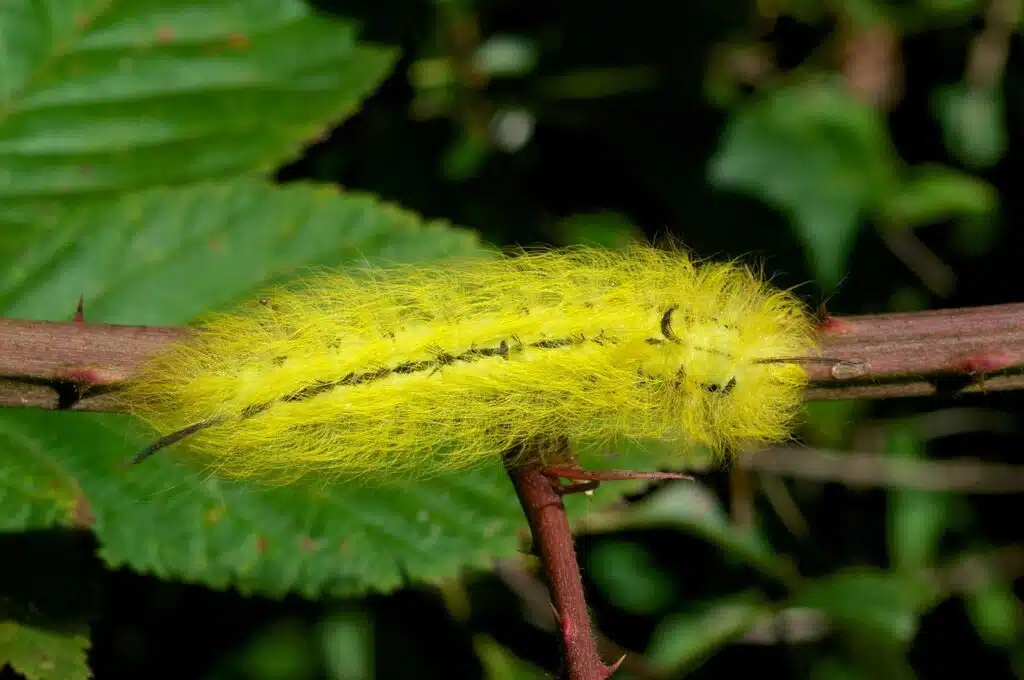
This type of caterpillar (Apatelodes torrefacta) has a vivid yellow color with a few tiny brown spots and stripes on its dorsal side.
Long yellow hairs cover the fuzzy caterpillar.
Black or dark brown contrasting spots are also seen on the species.
This caterpillar lives on Eastern North America’s common trees. It lives and feeds on oak leaves, maple, ash, cherry, and plum trees.
The adult Spotted Apatelodes Moth Caterpillar doesn’t carry on its yellow color into adulthood.
Once they reach the adult stage, moths of this family are gray, dark brown, and black. They blend in with the environment without any vivid colors.
The species grows up to a size of 42mm.
2. Cloudless Sulphur Caterpillar

Cloudless Sulphurs (Phoebis sennae) are marked by yellow colors across all life stages.
The caterpillar of this yellow butterfly is yellow itself. It has a uniform bright yellow color later showing light green bands across the body.
The species also has light yellow ventral coloring, making it an almost completely yellow caterpillar.
Cloudless Sulphur Caterpillars aren’t always as yellow. The emerging caterpillar in its early growth stages has a slight green tint.
Its yellow color richens as the species grows.
These types of caterpillars may be found on host plants with yellow flowers, which may explain their coloring.
Partridge peas are among the most common hosts of the caterpillar.
Its final size depends on its feeding habits and food availability as the caterpillar doesn’t feed on pollen as adults.
These caterpillars may reach a size of 45mm.
3. Spicebush Swallowtail Caterpillar

Spicebush Swallowtail Caterpillars (Papilio troilus) turn yellow in their later growth stages.
This caterpillar begins life as a brown species and it only turns yellow in its later instars.
The species seen in multiple broods in different areas of North America may also show brown or yellow color differentiation depending on the season.
The brown or yellow color of its pupa is also seen according to the seasons. A brown pupa is characteristic of Spicebush Swallowtail pupa in the winter while a yellow color may be seen in the summer.
Apart from the main yellow color (sometimes with green undertones), this caterpillar is also known for its large eyespots on the head.
Looking similar to a small snake, this caterpillar uses contrasting colors and eyespots to send off warning signs to predators.
4. Virginia Ctenucha Caterpillar
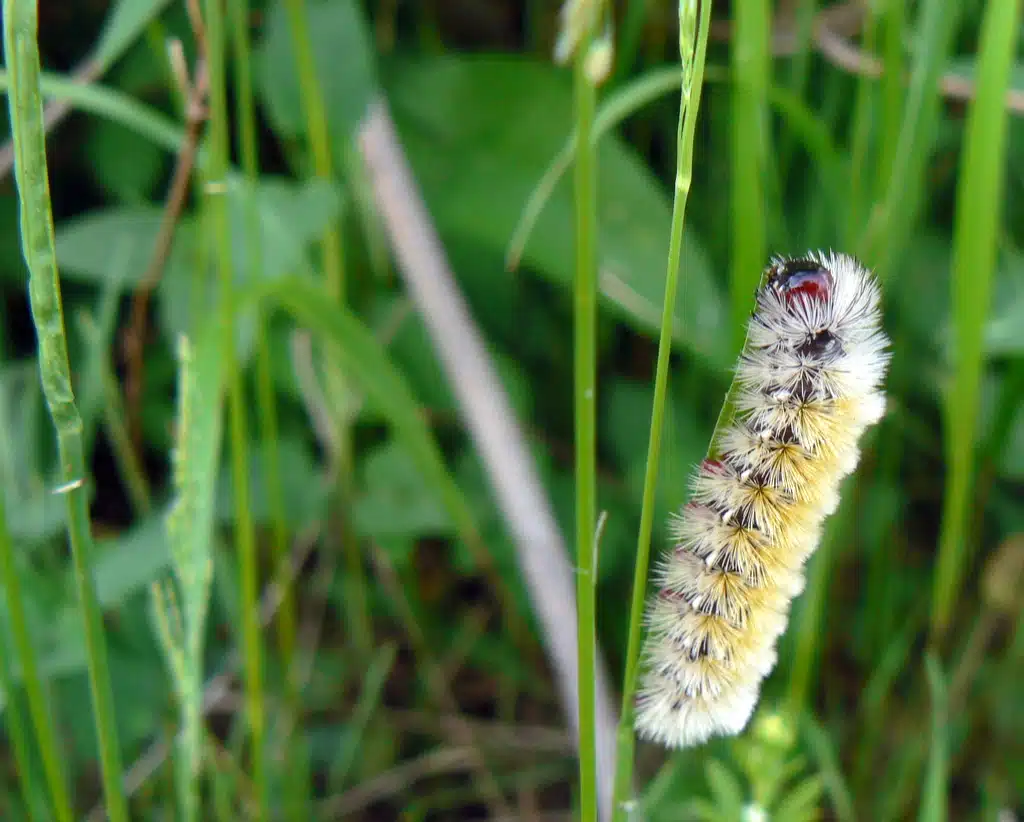
Virginia Ctenucha Caterpillars (Ctenucha virginica) have a mostly yellow color with significant white and black sections as well.
A hairy body is specific to the species in its early growth stages. Long yellow and black hairs decorate its body.
White spike-like hairs are also seen on its body in its later instars.
You can find this caterpillar species across Northeastern US territories.
It feeds on various types of grass as it grows and it generally takes on a multi-colored appearance in its later growth stages.
Virginia Ctenucha Caterpillars are black and yellow in their first days. They also grow red or red-brown legs which become more visible in the last days before pupation.
The adult partially carries yellow coloring at the base of its forewings which are either yellow or orange.
5. Grapeleaf Skeletonizer Moth Caterpillar
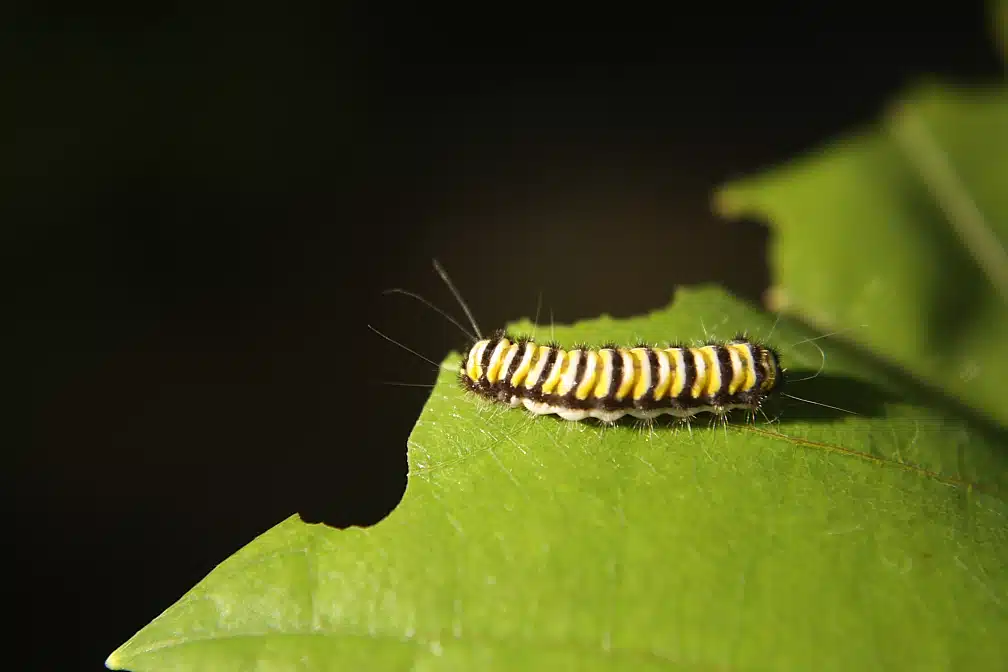
This species (Harrisina americana) begins life as a yellow egg. Clumps of yellow eggs are laid on the underside of the leaves.
As it grows, the Grapeleaf Skeletonizer Moth Caterpillar maintains its yellow color which darkens.
Black bands start to appear on the dorsal side of the caterpillar.
The alternation of black and yellow is believed to help the species stay safe in face of its potential predators.
This species is also seen as a pest in some North American regions.
While not a true pest, its role is minor as it prefers to feed on the leaves of wild grapes.
Cultivated grapes are only partially impacted by the species which tends to prefer imported vines in Florida.
6. Western Grapeleaf Skeletonizer Moth Caterpillar

Western Grapeleaf Skeletonizer Moth Caterpillars (Harrisina metallica) begin life as a yellow species in their first instars.
Black and gray bands appear on the species in its pre-pupation stages.
Adult moths of the species don’t maintain yellow coloring as they turn black with small red sections across the body.
California is one of the states where the Western Grapeleaf Skeletonizer Moth Caterpillars are seen as a major pest.
It affects cultivated grapes in vineyards. The species eats entire leaves and hinders grape production.
High reproduction rates mean the impact on grape leaves is considerable when it comes to the species.
This species is also commonly found in Texas.
7. American Dagger Caterpillar

American Dagger Caterpillars (Acronicta americana) have elongated bodies covered in long yellow hairs. Black tufts contrast its pale yellow color.
The bright yellow color of the caterpillar is also contrasted by its large black head.
Unlike other species, the American Dagger Caterpillar has long hairs in all of its growth stages.
These hairs start to brighten as the caterpillar grows and might even turn completely white in its last instar.
Apart from its bright color, it’s believed the hairs of the caterpillar are urticating. They might cause skin irritation in humans.
This species is a North American native that lives in woodlands.
It can be found feeding on various tree leaves.
8. Wood Leopard Moth Caterpillar

Wood Leopard Moth Caterpillars (Zeuzera pyrina) get their name from the spots seen on the adult.
Even the caterpillar has tiny black spots but it also has a yellow-dominant color.
Its yellow nuance is bright while its contrasting head is brown.
Wood Leopard Moth Caterpillars have known pests around the world. They feed on the leaves of trees.
Fruit trees are particularly affected by the species. Trees such as apple trees are commonly infested by the species.
One of the first signs of the species on fruit trees apart from seeing the caterpillar on the tree is seeing dead leaves.
Multiple dead leave signal a potential tree branch is about to die as well. At the same time, these caterpillars might as well kill a tree either in one year or with multi-year damages.
9. Cottonwood Dagger Caterpillar
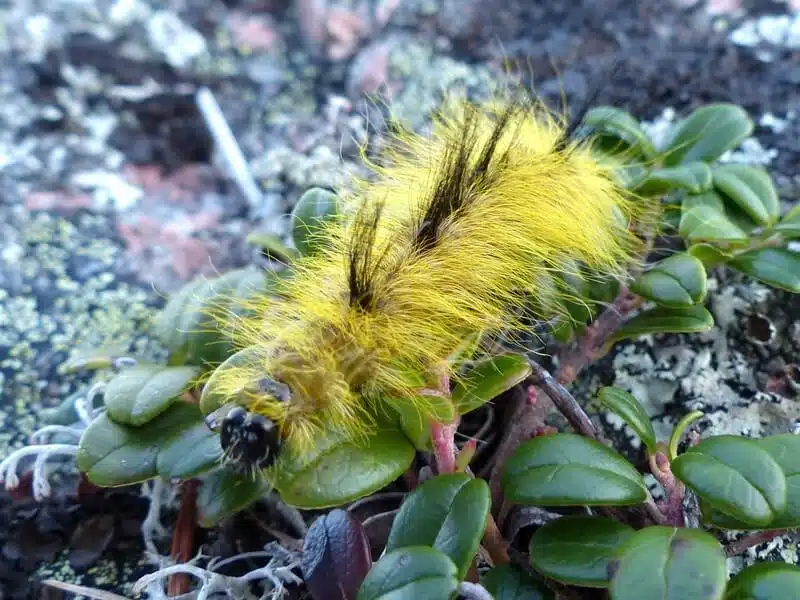
Northern and Northeastern US territories are home to the Cottonwood Dagger (Acronicta lepusculina).
This moth has white and gray coloring but its caterpillar is yellow.
Long yellow hairs cover the entire body of the Cottonwood Dagger Caterpillar. The species has a central brown to the black band on the dorsal side and long black tufts.
The yellow hairs of the species can sometimes change nuances as the caterpillar grows. They might become brighter as the caterpillar approaches its last instar.
You can find Cottonwood Dagger Caterpillars across woodlands and along rivers.
The species is known to feed on willow and oak leaves which means it can be found in many types of Eastern habitats up to very high elevations.
10. Delightful Dagger Caterpillar
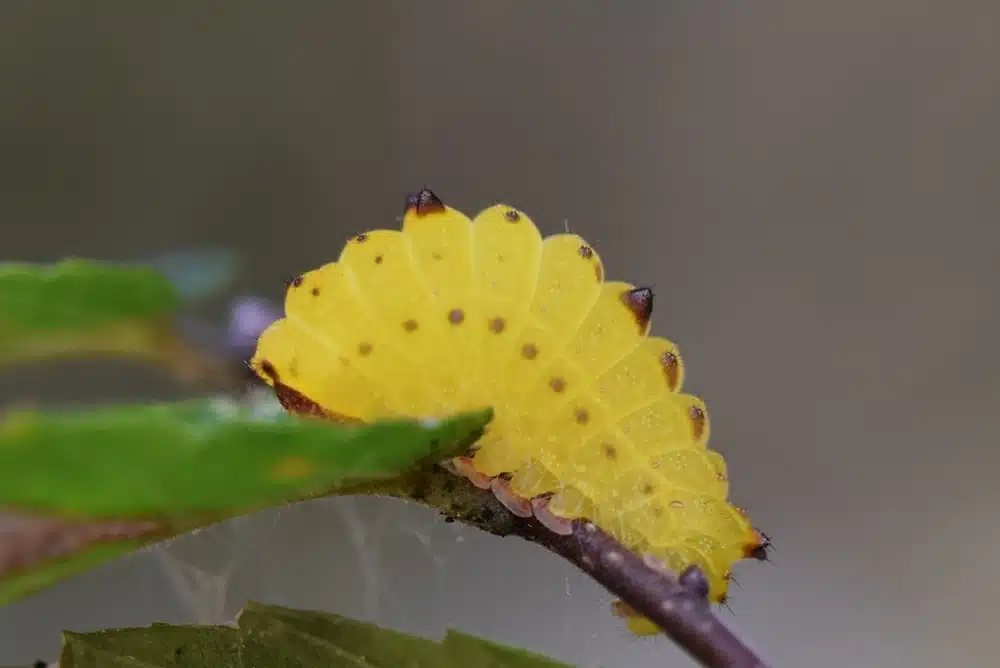
Delightful Dagger Catterpilalrs (Acronicta vinnula) have a yellow or yellow to green color. All variants of the species have 2 white dorsal stripes.
The head of the caterpillar is partly yellow and partly brown.
Caterpillars of this genus can be seen on different trees. Feeding on various tree leaves, they can sometimes be spotted eating elm leaves.
You can find this caterpillar from spring to summer. April is the earliest month the adult moth appears from the pupa.
The species is small as even the largest Delightful Dagger Caterpillar measures 32mm.
11. Santa Ana Tussock Moth Caterpillar
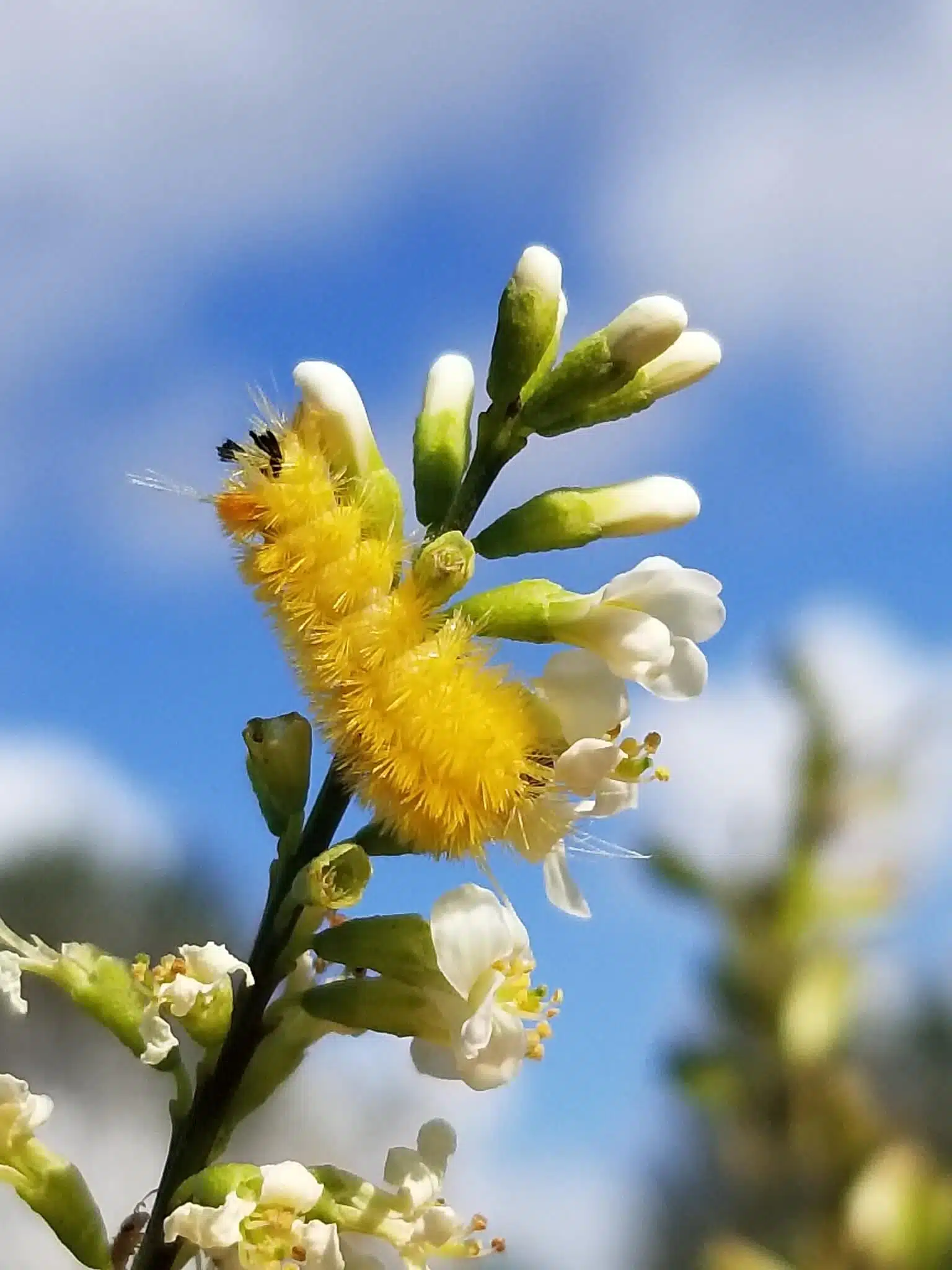
This species (Lophocampa annulosa) is endemic to Southern Texas and Mexico.
It starts life as a pale yellow species slowly turning into a yellow caterpillar.
Its body is covered in short yellow hairs with white tufts and small brown patches. The species also has a brown head.
Santa Ana Tussock Moth Caterpillar hairs can trigger mild skin irritation so it’s best to handle it with care.
This type of caterpillar is seen in many tropical and sub-tropical species.
It feeds on the leaves of different wild and cultivated citruses.
Adult Santa Ana Tussock Moths also carry some of the colors of their caterpillar stages into adulthood.
This species has yellow forewings with brown veins and yellow-brown legs.
12. Vine Sphinx Caterpillar
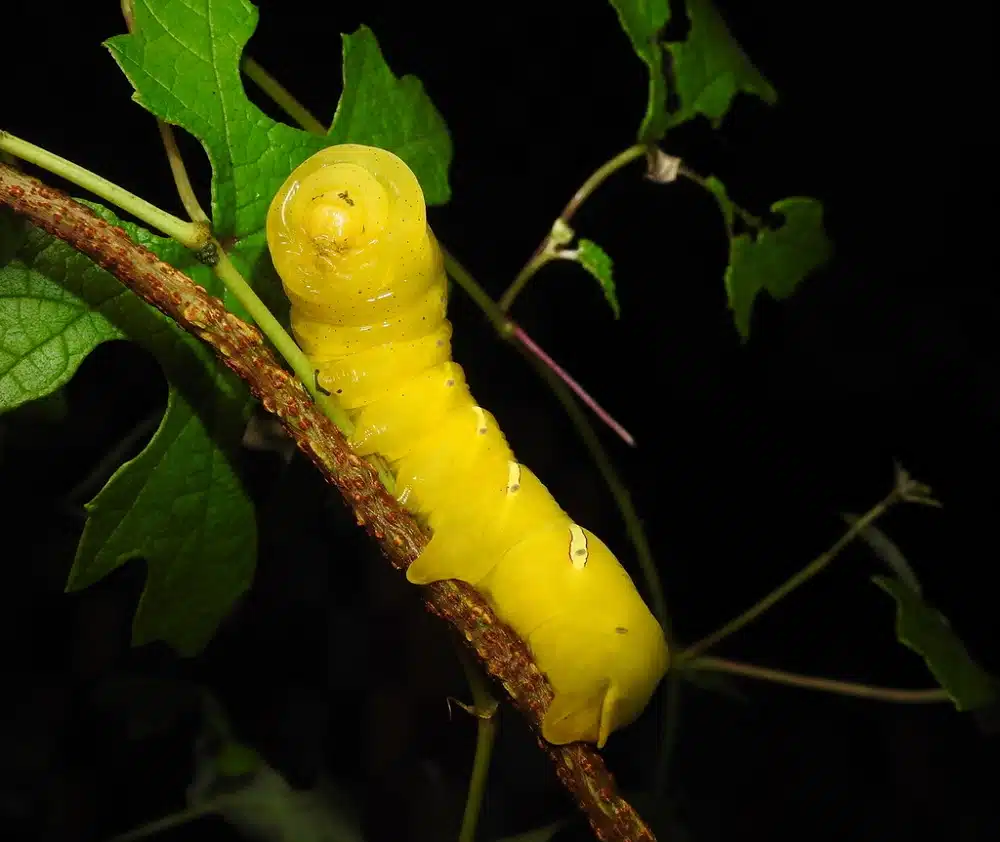
Yellow color is specific to a morph of this common caterpillar (Eumorpha vitis). The species also comes in green and brown morphs.
Vine Sphinx Caterpillars have a simple yellow body and yellow legs.
Tiny black spots decorate the dorsal side of the species.
Vine Sphinx Caterpillars are native to Southern and Southeastern US regions.
Largely found across Texas, they also have a growing presence in Florida.
Grape vines are common hosts of the species.
The caterpillar feeds on vine leaves making it one of the most important pests of this species.
Its damage to vines is limited to all of its caterpillar growth stages as adult moths take on flower pollen for food.
13. Stinging Rose Caterpillar
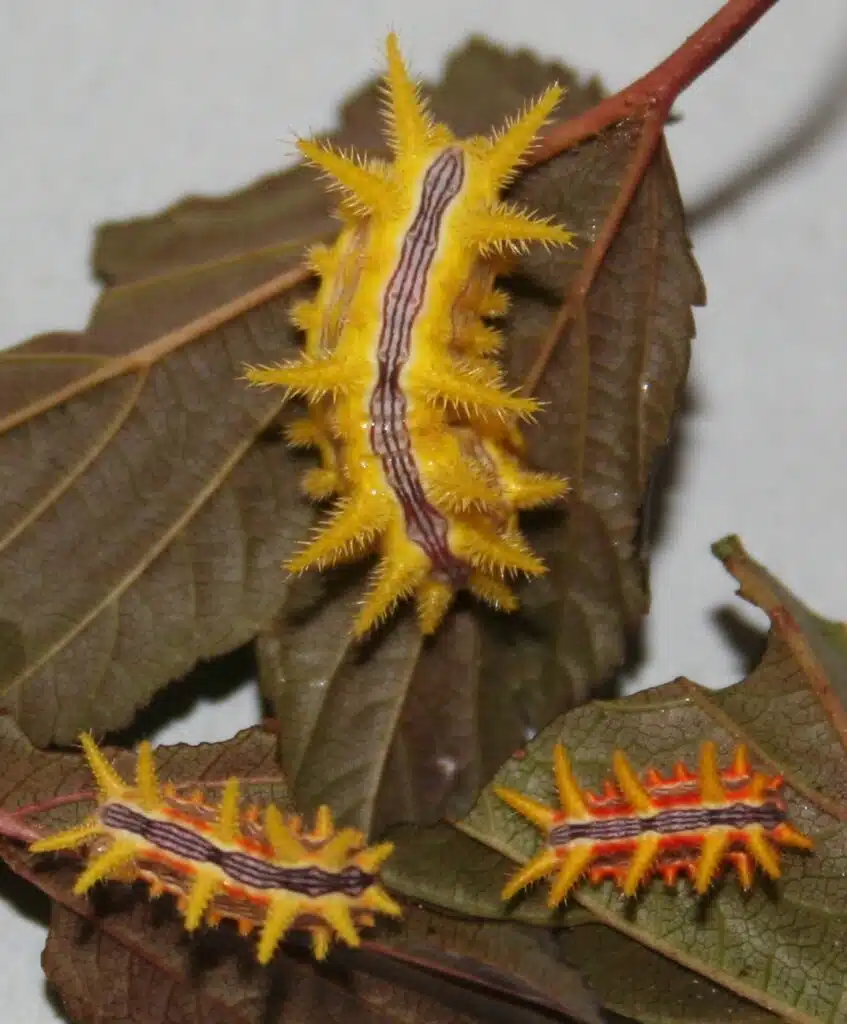
This species (Parasa indetermina) also comes in yellow but it has a rare status.
Caterpillars of this group have yellow and orange coloring. They also have a gray and a black central dorsal stripe.
Long yellow spike-like formations make the caterpillar appear more dangerous than it is.
The adult of the species also carries yellow coloring but to a very small extent.
Adult moths of the species are mostly green with brown or orange marks and thin yellow separating sections between these dominating colors.
The species has a wide range of host trees which include fruit trees as well as oak, maple, and rose.
Caterpillars of the species are to be avoided.
Their yellow spines sting and cause local skin-level pain and itching.
14. Io Moth Caterpillar
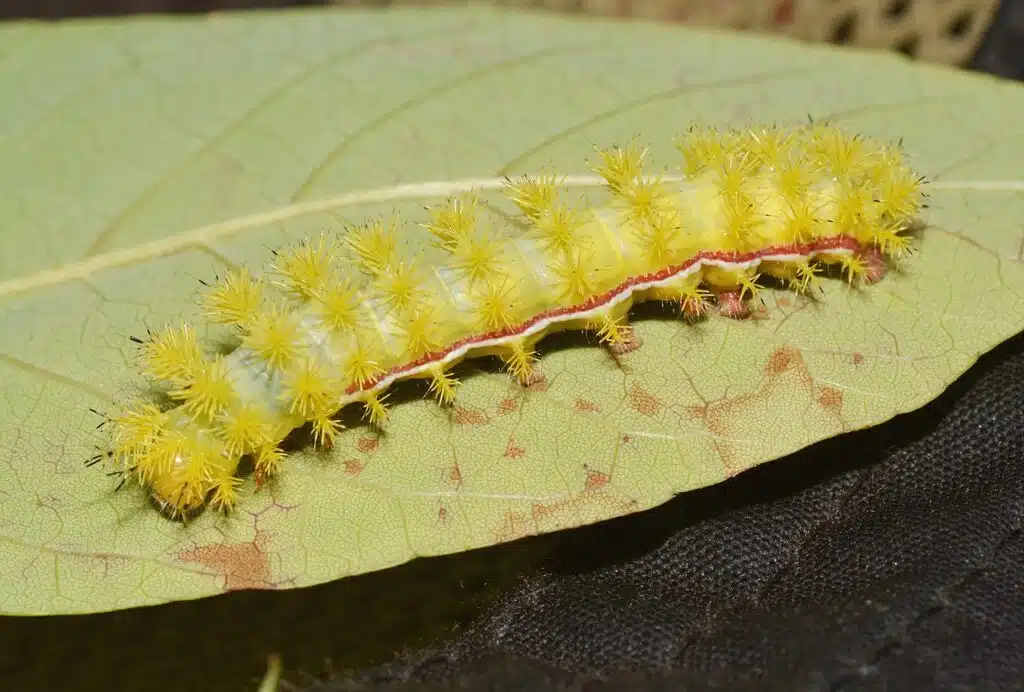
Io Moth Caterpillars (Automeris io) begin life as yellow and white eggs.
Dual color eggs are rare in the world of moths. The yellow part of the eggs starts to become orange within a few days.
Small orange caterpillars emerge only for the species to turn yellow again as it approaches the final dual instars.
The species becomes a dark orange-brown caterpillar covered in short yellow hairs.
The spike-like hairs of the species are actual spines that cause skin damage, pain, and irritation to humans.
This species maintains a smaller percentage of yellow coloring than an adult moth.
Io Moths have large black eyespots on a yellow background when they show their hindwings as their forewings are mostly brown.
15. Banded Tussock Moth Caterpillar

The Banded Tussock Moth Caterpillar (Halysidota tessellaris) has a yellow color with a dorsal brown band.
White and brown stages or morphs are also specific to this caterpillar species.
Native to Eastern territories of North America, this is a controversial species as it can cause skin irritation.
However, it also causes skin irritation in people with sensitive skin.
You can find Banded Tussock Moth Caterpillars in US and Canada oak woodlands. It also grows on individual oak trees, willows, and ash.
The species carriers yellow coloring into adult moth lifecycles. It has a yellow body with an orange tint.
16. Miller Dagger Caterpillar
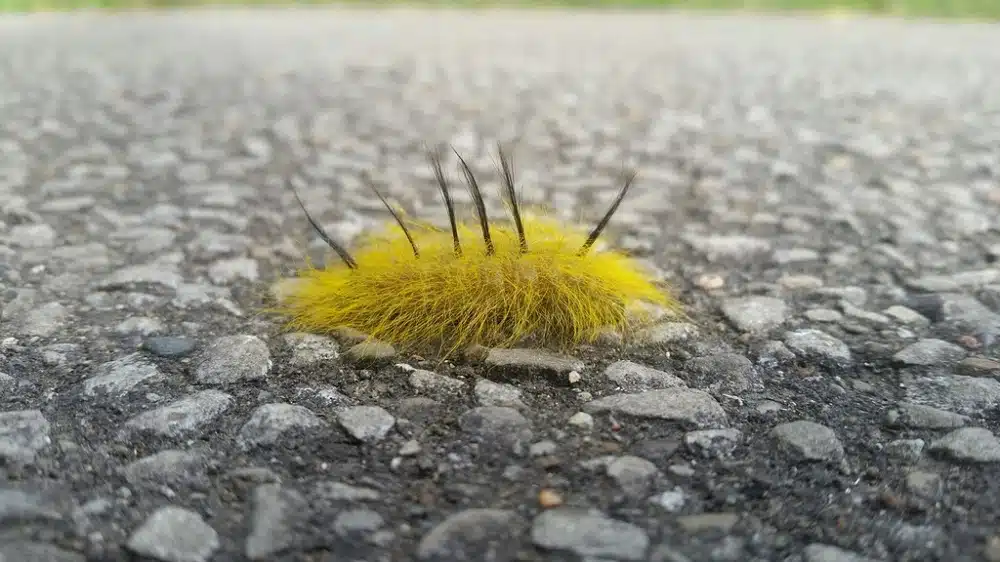
Tree leaves are the food of Milled Dagger Caterpillars (Acronicta vulpina). The species is found in birch, poplar, and aspen.
Seen in the early days of summer, this species is native to Northwestern territories of North America.
It has very long yellow hairs that cover its gray body.
There’s no scientific confirmation for the irritating nature of these hairs.
Some people with sensitive skin have been known to react whenever touching this species.
You can find these types of caterpillars feeding on tree leaves in woodlands. They rarely appear on birch or alder planted in gardens and around cities.
17. Black Arches Caterpillar
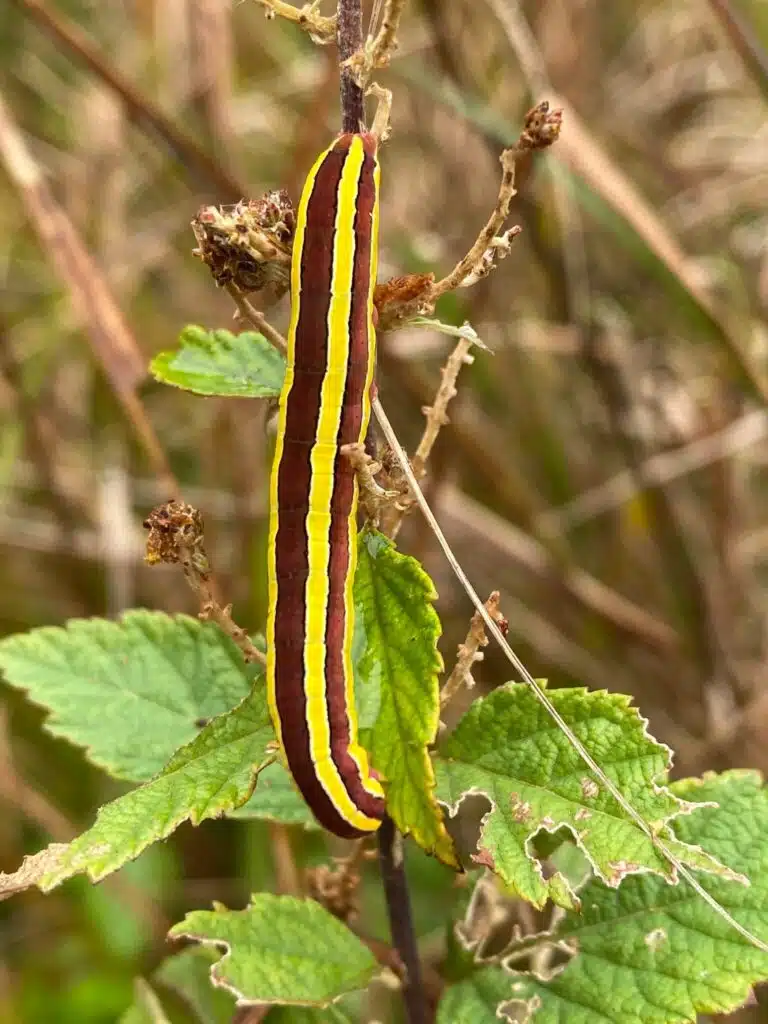
A colorful appearance is specific to the Black Arches Caterpillar (Melanchra assimilis). This is a species dominated by both yellow and green colors.
Alternating green and yellow bands along the sides of its body keep many predators away.
This vivid color combination can make the species look toxic.
Yellow coloring isn’t seen on the Black Arches moth which is almost completely black.
You can find Black Arches Caterpillars on plants and trees. These caterpillars may feed on goldenrod but they’re also seen on trees.
Alder and willow are among the most common hosts of the Black Arches Caterpillar.
This species is seen at the beginning of the summer season. Its range expands across Eastern North America.
18. Orange-barred Sulphur Caterpillar
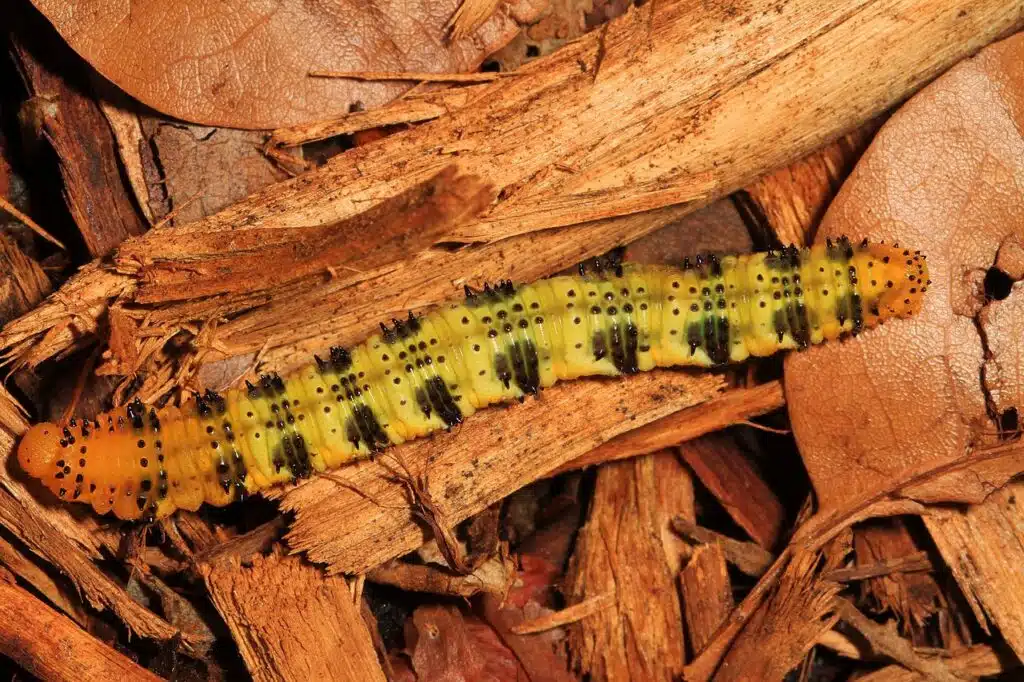
Yellow or green are specific colors for the Orange-barred Sulphur Caterpillar (Phoebis philea).
This species has tiny black dots across its dorsal side. Larger black spots are also seen across its body as the species matures.
Found across Southern territories, the species is seen in Southern states and across Mexico.
A wide range of cassias are hosts of the species. Small decorative trees or shrubs are perfect hosts for the caterpillar.
Adults carry on yellow coloring as well. Yellow is the dominant color of the underwings.
Orange-barred Sulphur butterflies move on to nectar as the main food.
This species is seen in multiple broods per year. Up to 3 Orange-barred Sulphur Caterpillars are seen in Florida.
19. Spotted Tussock Moth Caterpillar
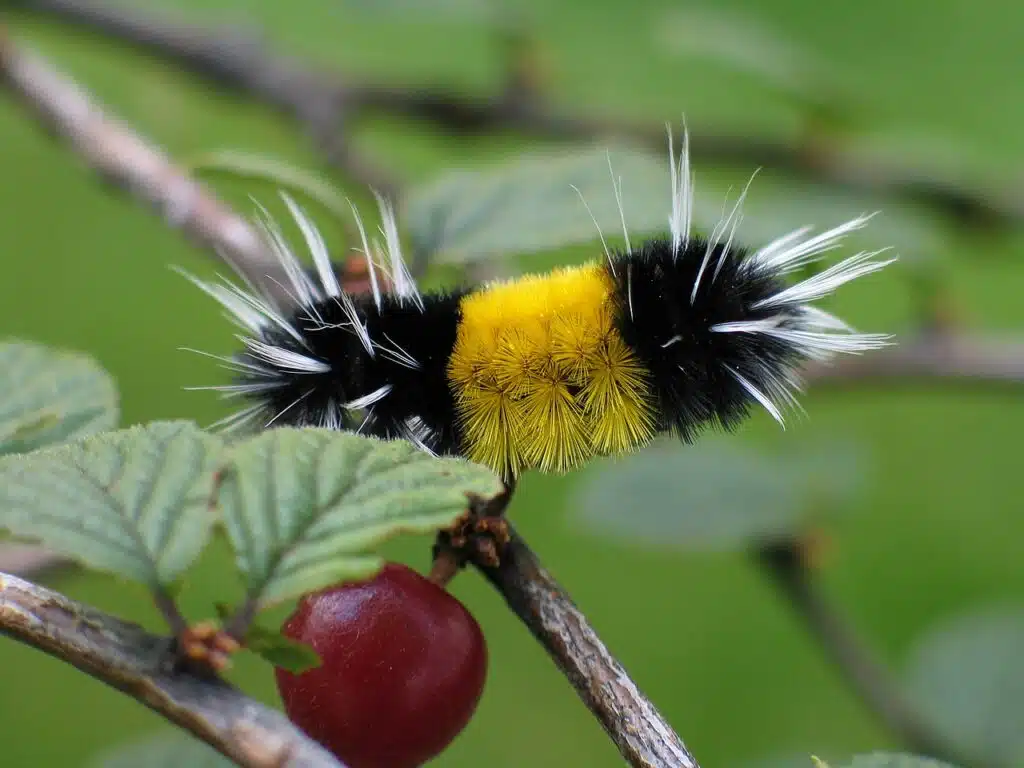
Western US territories are home to the Spotted Tussock Moth Caterpillar (Lophocampa maculata).
Black and yellow colors are specific to the Spotted Tussock Moth Caterpillar.
This species has a yellow central section across its body while its extremities are black.
Rare morphs of the species are almost completely white.
Even the black and yellow caterpillar can grow white hairs towards its late instars.
The Spotted Tussock Moth Caterpillar feeds on tree leaves with a pest status in some areas.
Hardwood trees are among the most common hosts of the species. Oak tree leaves are regularly consumed by the caterpillar.
20. Southern Ugly-nest Caterpillar

This species (Archips rileyana) begins life as a dark caterpillar to eventually becomes a yellow species.
Yellow is the dominant color of the species which exhibits tiny black spots and a black head.
This caterpillar is also known for being present across Southern territories. Its range includes Southern Texas.
Buckeye species are the most common hosts of the Southern Ugly-nest Caterpillar.
This species is occasionally spotted on hickory.
Bright orange-yellow colors are also seen on the adult of the species. The moth is only seen until mid-summer.
21. Yellow Woolly Bear
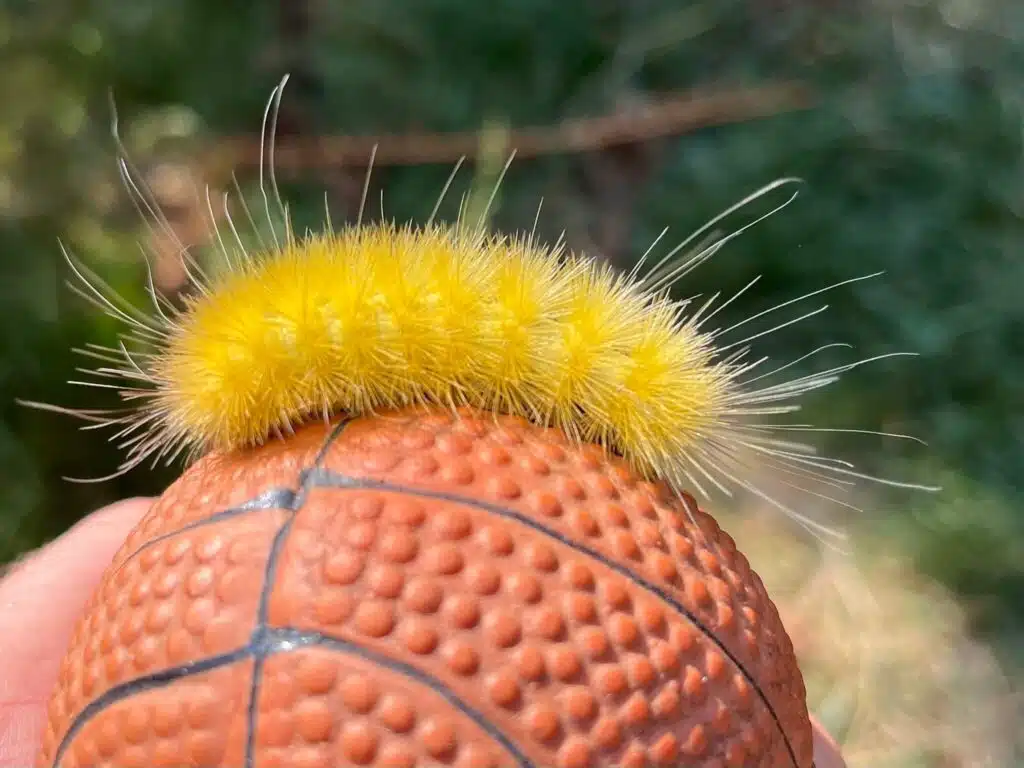
Yellow color is specific to the Yellow Wooly Bear (Spilosoma virginica). This basic color can come in different shades and it tends to darken.
The species may eventually become orange in its last instars, even if it maintains some yellow hairs.
Caterpillars of the species are known as pests through the defoliation of crops, flowers, and trees.
Grasses are among the most common hosts of the species. Clovers are also invaded by the species.
The highest level of damage caused by the caterpillar is seen in the second part of the summer.
Seen on clover fields across Eastern US states, the species loses yellow coloring as an adult.
The adult moth is mostly white with black spots on its hindwings.
22. Rocky Mountain Agapema Caterpillar
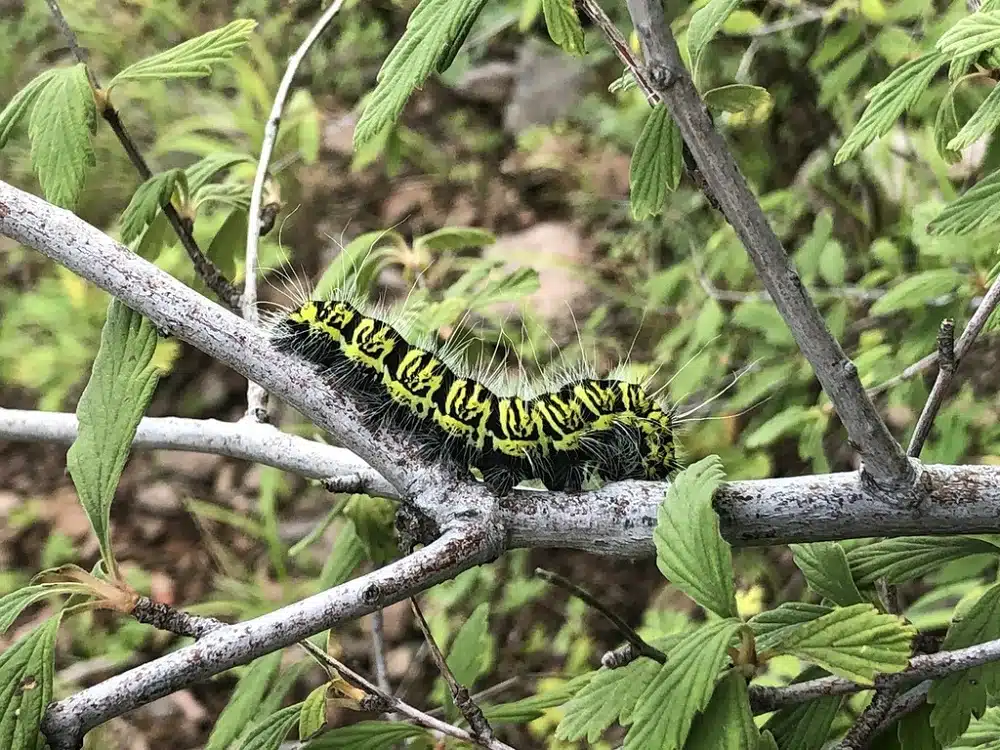
This type of caterpillar (Agapema homogena) is tied to the range of The Rocky Mountains.
It’s among the few caterpillars seen at high elevations. Growing in a habitat at elevations of a few thousand feet, this species feeds on currants and other shrubs.
It can be found on a few different host trees as well.
The Rocky Mountain Agapema Caterpillar is an important defoliator as the adult moth doesn’t feed.
You can identify the species by black and yellow contrasting colors.
Both colors are seen in similar percentages across its body. This species also has scarce yellow hairs.
23. Ruddy Daggerwing Caterpillar
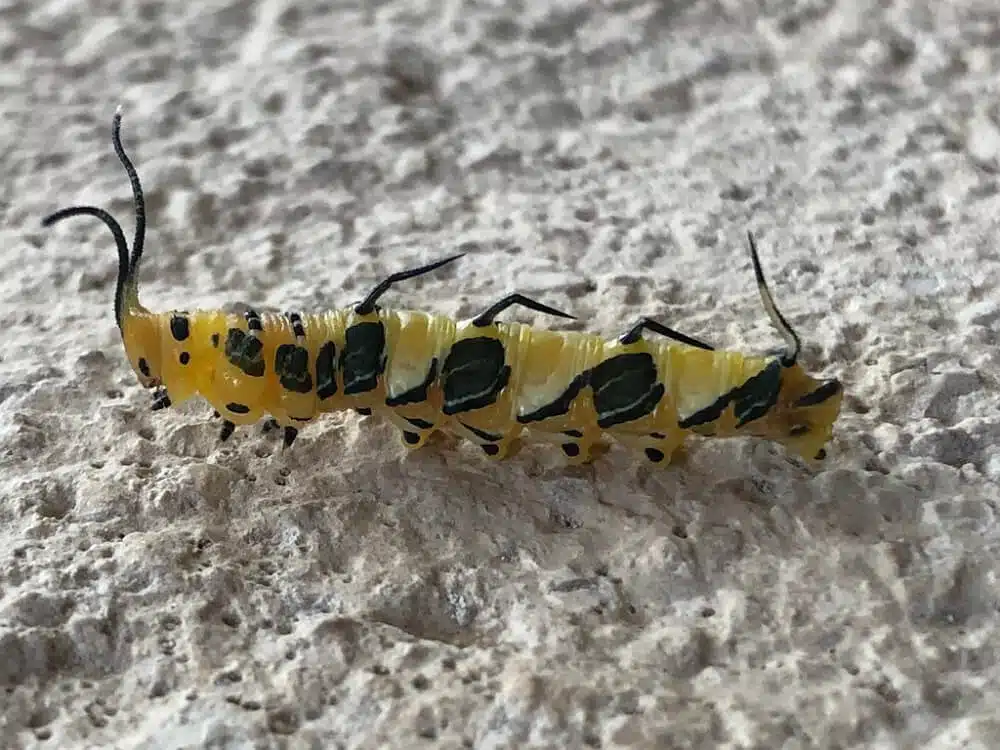
Native to Southern Florida, Texas, and Southern Arizona, the Ruddy Daggerwing Caterpillar (Marpesia petreus) is a species with partial yellow coloring.
Red and black colors are seen on the lower side of its body while its central dorsal color is yellow.
The species only maintains slight nuances as an adult as its wings are mostly orange.
Woodlands and swamps are common habitats of the Ruddy Daggerwing Caterpillar.
Various species of fig are the hosts of the caterpillar.
Adults move to nectar-rich plants such as milkweed.
24. Silver-spotted Tiger Moth Caterpillar
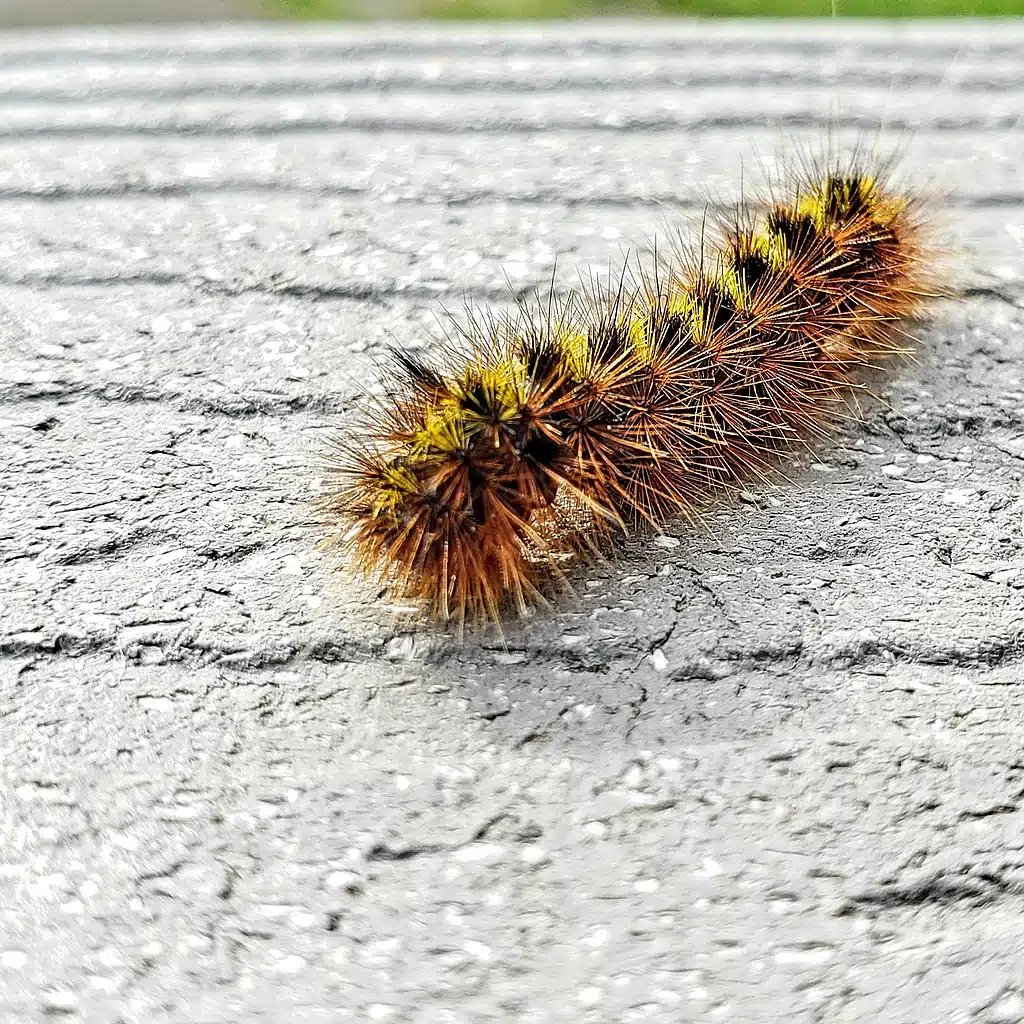
Western North America is the native range of the Silver-spotted Tiger Moth Caterpillar (Lophocampa argentata).
This is a species that have yellow nuances both as a caterpillar and as an adult moth.
While initially yellow, the caterpillar becomes black and orange in its later instars.
This species also carries a yellow-to-orange nuance as an adult.
Both the forewings and the hindwings of the species are marked by yellow nuances.
This species is seen across different mid to high-elevation Douglas-fir habitats.
This caterpillar has a wide and short body compared to other caterpillars. It may reach a maximum 1.5-inch length in its last instar.
25. Sycamore Tussock Moth Caterpillar

Sycamore Tussock Moth Caterpillars (Halysidota harrisii) begin life as a white species that slowly turns yellow.
These caterpillars are known to use sycamore trees as hosts. Many know this tussock moth for the skin reaction its hairs cause.
As with other types of tussock moths, these caterpillars cause skin rashes.
While not a significant pest, the caterpillar can also turn detrimental to its host tree as it can grow in large populations at times.
Known for also displaying orange tufts, this species is mostly seen on Eastern North American sycamores.
The invasive status of the species may be prevented by removing the eggs of the species. Sycamore Tussock Moth Caterpillar eggs are laid directly on tree bark.
26. White-marked Tussock Moth Caterpillar
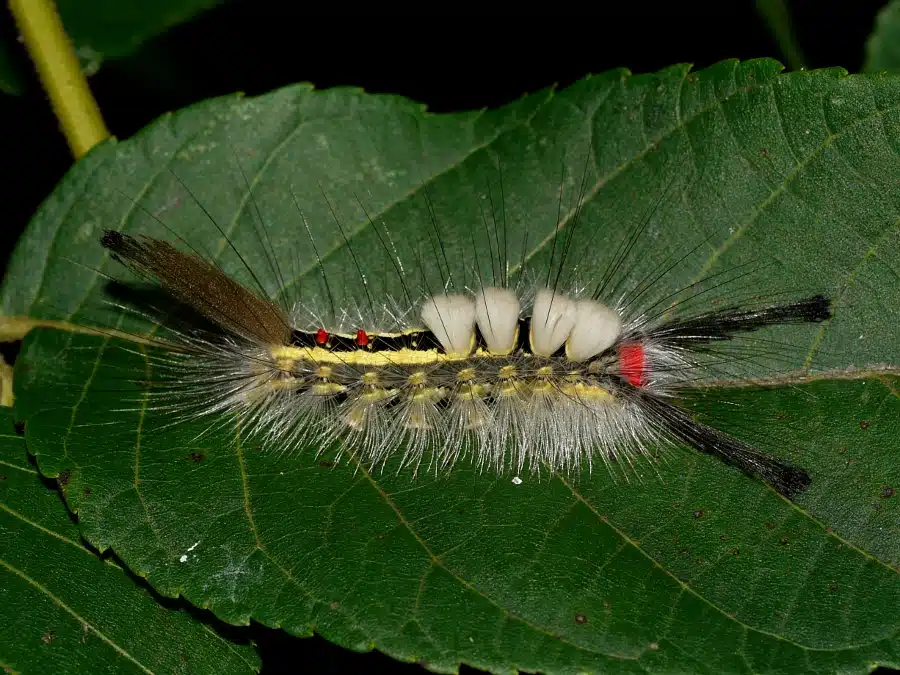
The White-marked Tussock Moth Caterpillar (Orgyia leucostigma) is known for the white dorsal stripe across its body.
A combination of yellow and black stripes makes this species distinct. Cream-color glands are also seen behind the head of the species.
Caterpillars of this family have the widest yellow coloring in the first 2 instars as the black coloring appears a few days later.
A large number of hardwood trees and fruit trees are hosts for the White-marked Tussock Moth Caterpillars.
The species is a known pest to maple and elm trees.
Other types of hosts include apple, chestnut, birch, and black locust.
Various management techniques have been piloted against this species.
Most invasions tend to bring viral infections which spread from one member of the species to another ending their presence in a given area.
27. Silver-Spotted Skipper Caterpillar

A yellow body with a brown head is specific to the Silver-Spotted Skipper Caterpillar (Epargyreus clarus).
As with many skipper species, the caterpillar has a longer body compared to the wingspan of the adults.
Silver-Spotted Skipper Caterpillars grow to a size of around 2 inches while adults have a shorter wingspan.
Some color resemblance exists between the caterpillar and the adult skipper.
While mostly brown, the skipper butterfly still has a yellow band across its wings.
You can find this North American caterpillar species on different types of vines in the pea family.
False indigobush is among the favorites of this species.
There’s little evidence to suggest a major pest role in the species, either as a caterpillar or as an adult.
Soybean is sometimes impacted by the adult skipper but to a small extent.
28. Cinnabar Moth Caterpillar
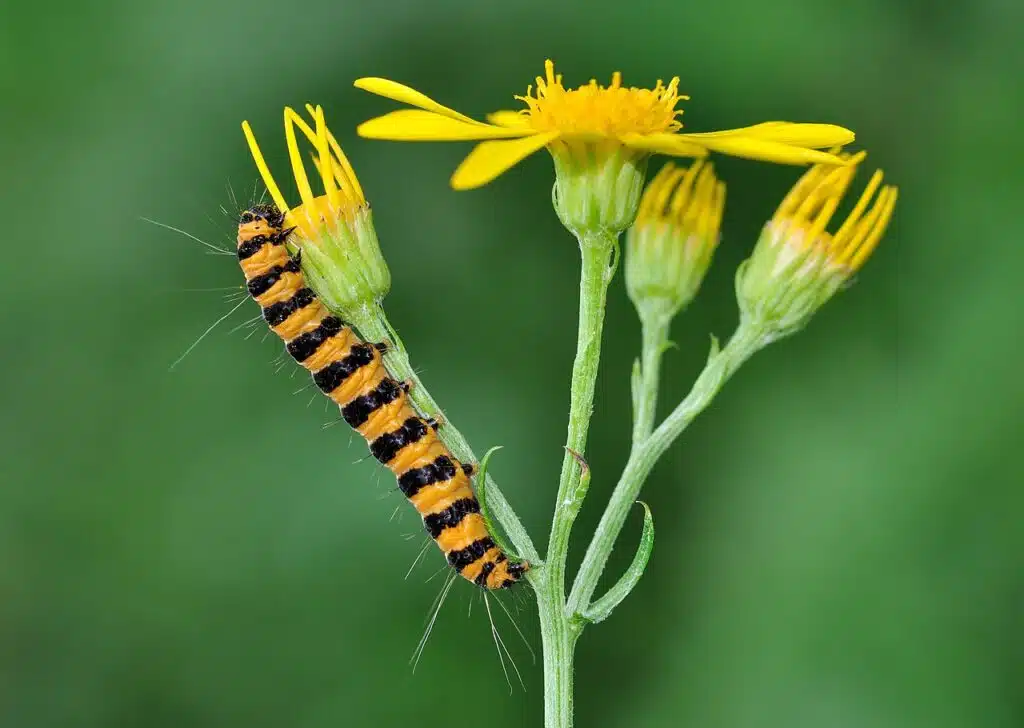
These types of caterpillars (Tyria jacobaeae) have a common yellow color with multiple alternating black bands.
Its yellow color often helps it blend in with its host plants with yellow flowers, such as ragwort.
These caterpillars start life as eggs laid on the underside of ragwort leaves. They then begin feeding on these leaves, still hidden below the leaves themselves.
Female moths can lay up to a few hundred eggs at once.
Once adults, they bear no color resemblance to the caterpillar.
The pupa of the species has a red-brown color while the adult moth is black with red stripes and red hindwings.
The specific red nuance of the species is a type of red that resembles cinnabar minerals.
29. Redhumped Caterpillar

This species (Schizura concinna) begins life as an all-yellow small caterpillar.
It doubles its size a few times until it reaches its final instar. Appearance changes are also specific while growing.
It changes colors to a yellow and black caterpillar from a yellow caterpillar.
Alternating yellow and black stripes dominate its appearance. A central white stripe is seen on its dorsal side towards its last instar.
30. Zebra Caterpillar
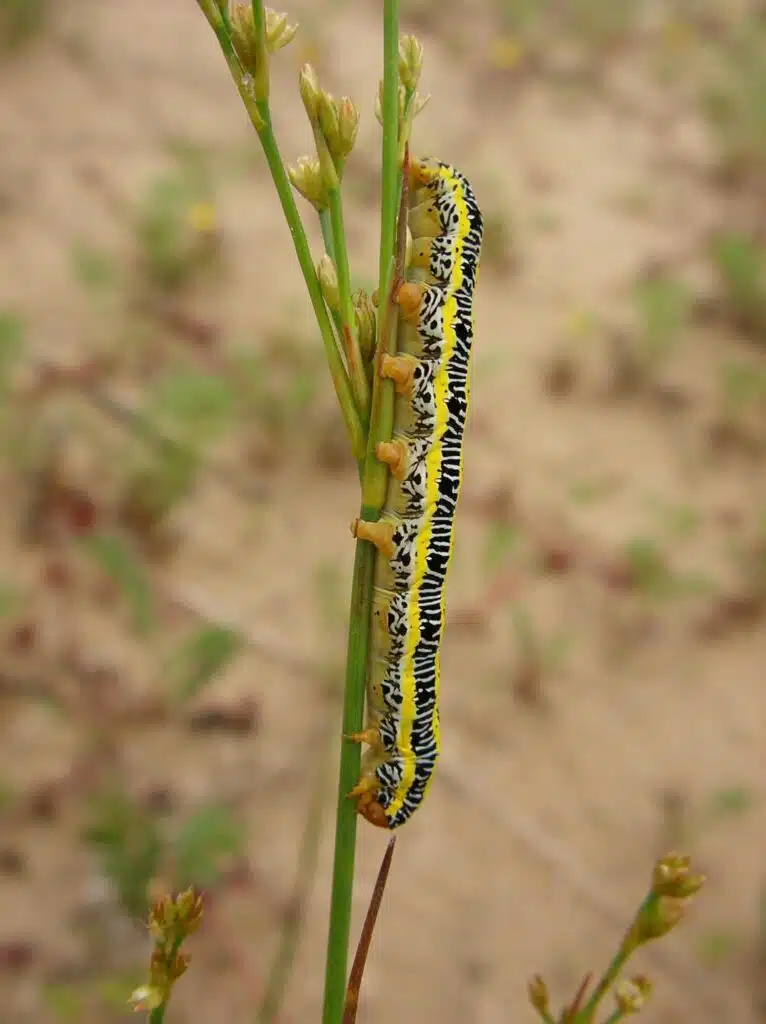
Zebra Caterpillars (Melanchra picta) are a species with a limited Northeastern US range to have yellow colors.
As its name implies, the species has a multicolored body.
Black and yellow stripes are joined by fine white lines across the body of the species.
Zebra Caterpillars have large brown heads.
The species is seen in small groups as the early instar Zebra Caterpillars feed together.
It disperses around ground-level leaves in later instars.
The species is typically not a pest until the largest number of caterpillars are seen in August.
31. Huckleberry Sphinx Caterpillar
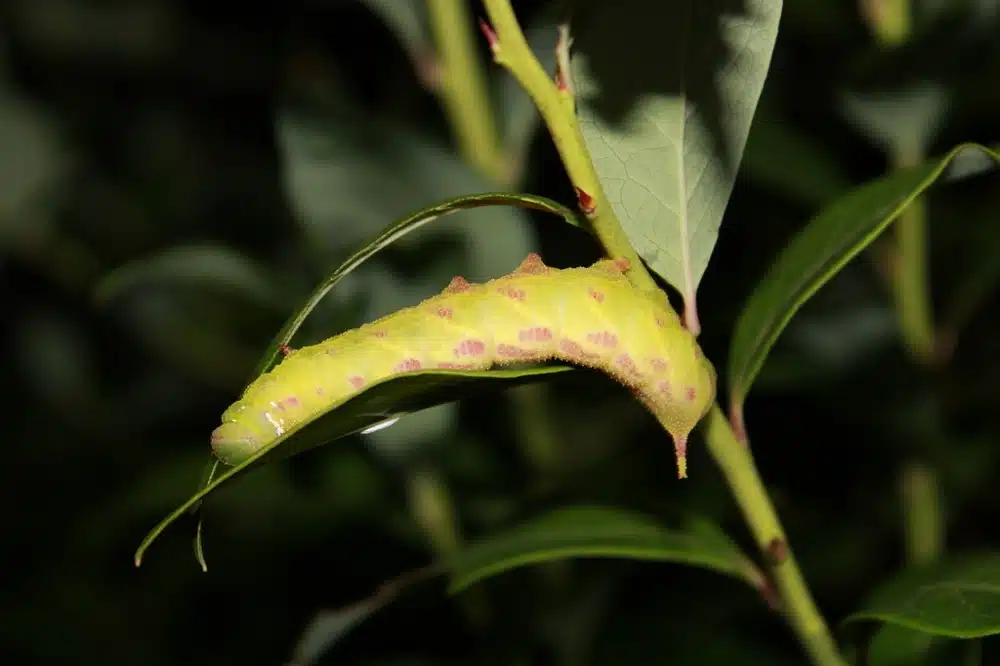
A green and yellow dual color are specific to the Huckleberry Sphinx Caterpillar (Paonias astylus).
This is a species known for being marked by yellow coloring through all of its life stages.
A green base color with yellow stripes and marks is specific to the caterpillar. The tips of its horns are also mostly yellow.
Huckleberry Sphinx Caterpillars grow into brown and yellow moths. The species has large yellow hindwings and brown to yellow forewings.
Huckleberries and blueberries are among the most common hosts of caterpillars.
Certain types of rosemary and willows are among the less common hosts of the species.
The range of the species is mostly tied to states on The Atlantic Coast.
A growing range is noted for the species.
Alabama and Louisiana now represent the Western limits of this species.
32. Orange-tipped Oakworm

A yellow to orange color of the adult moth inspires the name of the species (Anisota senatoria).
Its caterpillar has a common striped appearance where yellow and dark stripes cover its body.
The species can come in yellow and black, gray, or dark green color stripes combinations.
This is a species that also has a black head.
Most Orange-tipped Oakworms seen across North America have a pest status. They can defoliate oaks in the summer or in the fall.
Red oaks are among the most exposed trees to its damage. Maple and other hardwood trees may also be affected by a growing number of caterpillars nearby.
This species lives in Eastern US territories with high activity in the second part of the day when the females lay eggs on trees such as oaks.
33. Long-horned Slug Moth Caterpillar
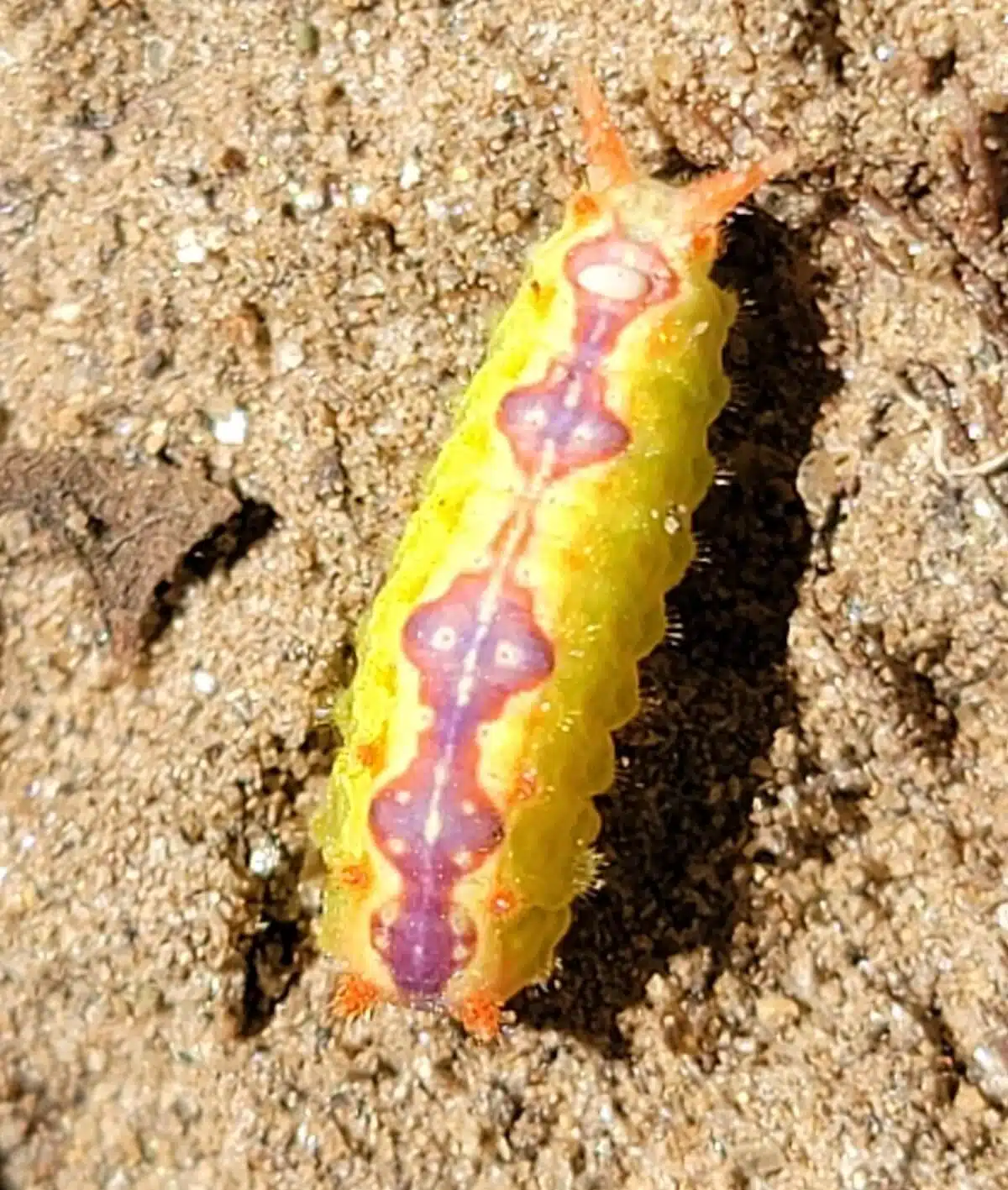
This species (Adoneta bicaudata) is one of the rare slug moth caterpillars. This is a genus that resembles slugs in its slimy appearance.
The caterpillar has yellow dorsum coloring, green lateral coloring, and central red markings.
Brown legs are seen on the species. These legs become hairy in late instars.
Other distinctive physical traits include short orange and yellow horns. As on the rest of the body, these horns might grow short white hairs.
Long-horned Slug Moth Caterpillars can rarely be seen feeding on leaves.
The combination of green and yellow coloring might improve their natural camouflaging appearance in front of bird predators.
34. Definite Tussock Moth Caterpillar
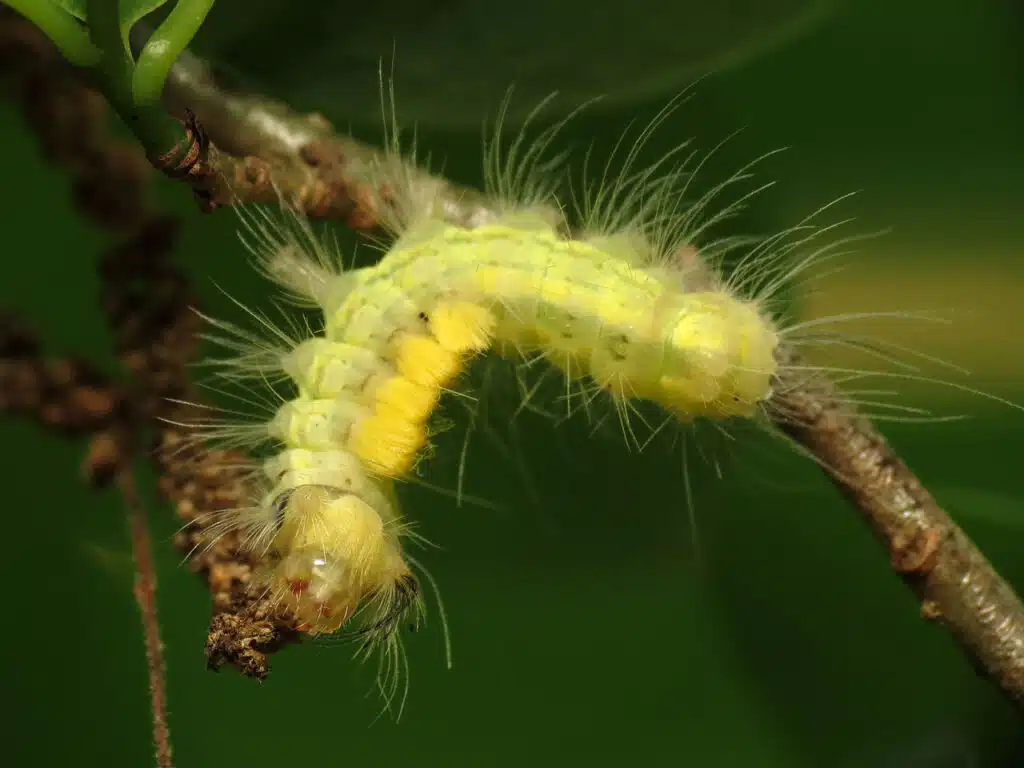
This species (Orgyia definita) is seen soon after temperatures don’t drop below the freezing line in the spring.
A pale green caterpillar at first, this species slowly becomes yellow.
It has a yellow-dominant color as it reaches its final instars. The species has a dark black dorsal stripe which is where 4 large yellow glands are also located.
Long white hairs are visible on the species at all growth stages. Brown tufts contrast its bright color.
These long hairs have the irritating factor that makes this species of Tussock moth caterpillar famous.
Skin irritation is a common occurrence when hairs touch hands.
Definite Tussock Moth Caterpillar hairs may also come off its body but they don’t lose their irritating factor.
Oak trees are among the most common hosts for the caterpillar. Tree damage is considered limited when it comes to this species.
Other hosts include willow and ash.
35. Yellow Sunflower Moth Caterpillar
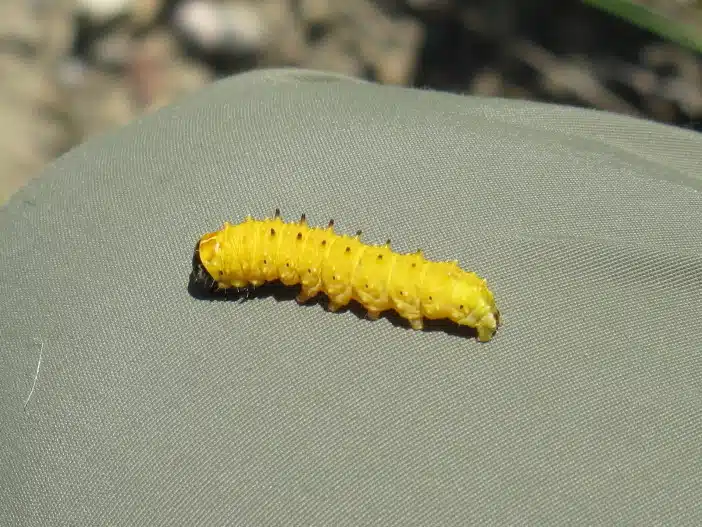
This species (Stiria rugifrons) begins life as a completely yellow species.
Black spots start to appear on this species as it grows. Eventually, it reaches a stage where it has a yellow color with black stripes and small black dots on its dorsal side.
The coloring of the species is closely tied to its hosts. The Yellow Sunflower Moth Caterpillar grows and feeds on the sunflower.
Various species of sunflower (not cultivated) are known to attract the caterpillar.
Porter’s sunflower is among the most common yellow flower plants to be a host for the species.
Yellow coloring is further linked to the adult moth. Brown and yellow are the main colors of the adult.
A range expanding from Minnesota to Southern Texas is specific to the species.
36. Genista Broom Moth Caterpillar

A yellow body with black sections describes the appearance of the Genista Broom Moth Caterpillar (Uresiphita reversalis).
This is a species seen in multiple broods per year with prevalent high populations seen at the end of the summer.
It has a yellow body with black and white dots. A blackhead also contrasts its bright color.
Acacias and lupines are among the favorite hosts of the species. Complete defoliation is not rare when it comes to the impact of the caterpillar on its host plants.
Moths of this genus also carry on the yellow coloring of their caterpillar stage. Their hindwings are all-yellow.
Management techniques against the Genista Broom Moth Caterpillar include the use of an insecticide.
37. Fir Tussock Moth Caterpillar
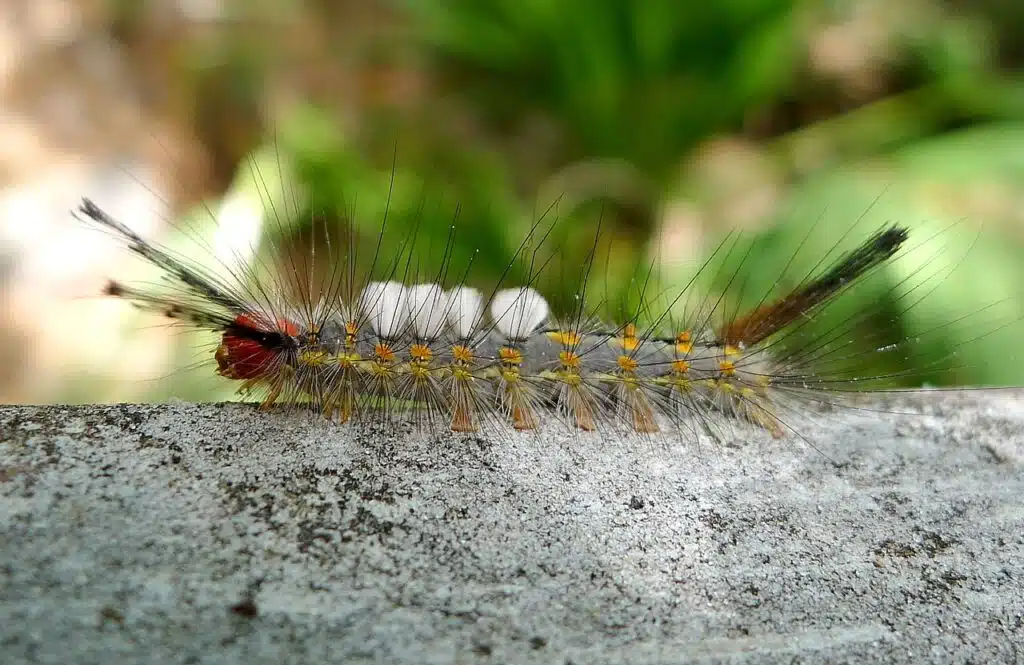
This type of caterpillar (Orgyia detrita) is known for the skin reactions it causes. Direct skin contact shortly leads to skin welts.
Reactions tend to appear in people with sensitive skin as others may show no direct reactions to touching the caterpillar.
Fir Tussock Moth Caterpillars come in 2 different colors.
A yellow-dominant form of the caterpillar has been seen across Southeastern US territories.
This is a species with further dark yellow spots and long white urticating hairs.
Oaks trees and cypress are among the hosts of the species.
While the species can be harmful in reproducing at high rates, it rarely causes considerable damage to oak trees.
They might migrate to another tree after they consume the leaves of an oak tree. While a rare sight, this is a sign that the infested tree might soon die.
38. Western Tent Caterpillar
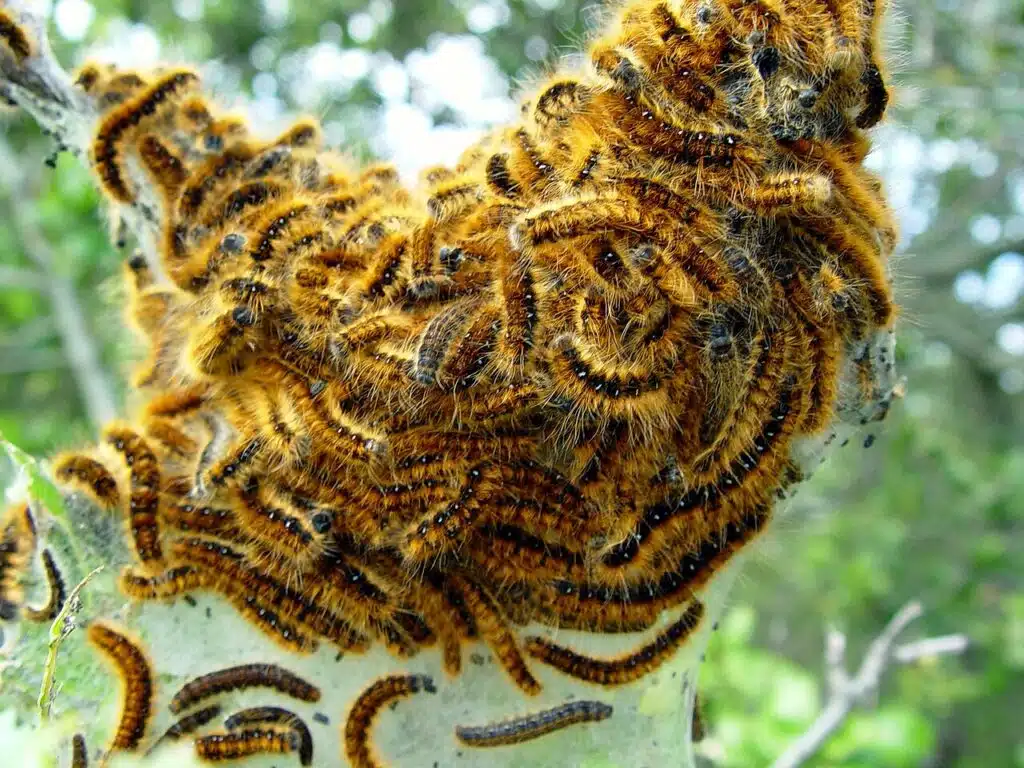
These types of caterpillars (Malacosoma californica) are seen together at first. They live in groups across the first instars.
Living without the capacity to produce body heat, the young caterpillars live close to each other for warmth.
They also move in direct sunlight for warmth.
Western Tent Caterpillars remain together up until their late instars. They need more food as they grow and they move on with solitary lives.
The food this species eats in the last stages as a caterpillar is the last food the species eats, in general.
Western Tent Moths don’t feed and they only live for a few days. It’s not uncommon for the adult moth to live only one day.
The caterpillars of the species have mainly yellow bodies with yellow or orange hairs.
39. Azalea Caterpillar

Azalea Caterpillars (Datana major) are born from small yellow eggs laid in clusters on the underside of leaves.
This species initially has dark yellow to orange coloring. It grows to a species with yellow and black stripes across its body.
Azalea Caterpillars show contrasting bright red legs towards their late instars.
Eastern US habitats are the home to this species.
It can be found in high numbers across Florida but also across other states.
This is a species that feeds on azalea in Southeastern habitats.
It can be a minor pest of apple trees in states further West.
These caterpillars have survival adaptations that allow them to avoid certain predators.
Silk threads are produced by these caterpillars which use them to drop either to the ground or to a lower level whenever disturbed.
The species eventually turns into a brown moth.